Buenos Aires to Lima
The third, and final, segment of our South American cruise began in Buenos Aires, Argentina and, after visiting five different countries, ended in Lima, Peru. Along the way we were treated to the capitals of Argentina, Uruguay, and Chile as well as the Chilean fjords and a trip around Cape Horn. The beauty of Ushuaia and Puerto Chacabuco astounded us. We were intrigued by the city of Iquique and the wooden sidewalks of it’s old town. Our trip ended with a nice day in Miraflores as we waited for our flight out of Lima.
New Staff and Passengers
There was a large of turnover of staff, including the captain, during our stay in Buenos Aires. So, this segment of our cruise provided us with the opportunity to meet many new staff, as well as passengers, on board ms Sirena.
There were 39 passengers who sailed all the way from Miami to Lima. The ship had a luncheon for us on this last segment of our South American cruise adventure. I was amazed that there were so many of the 39 that we had never seen up to that point. It’s funny, but when you are on a cruise there are some people that you see over and over again, even on a large ship. But there are others who you see for the very first time on the day of disembarkation; you can’t help but wonder, “Where have these people been?” This wouldn’t be so surprising on a ship with thousands of passengers, but on a ship that only carries 684, I thought we would have seen everyone in five weeks’ time.
Buenos Aires, Day Two
On our second day in Buenos Aires, we took the ship’s complimentary shuttle into town. It was very overcast, and by the time we got into town it was drizzling. It wasn’t raining enough to use an umbrella, but enough to get us pretty damp. But, we braved it and went on our way.
Exploring on Foot
While on our tour of Buenos Aires the previous day, our guide pointed out a clock tower. The British built the tower in 1916 as a gift to the city commemorating Argentina’s independence. However, after the Malvinas War (called the Falklands War by the British) in 1982, the name was changed to Monumental Tower. This was the first of several times we saw the repercussions of this war during our South American cruise. Since the shuttle dropped us off here, we walked around the park and took a few photos.
Apparently the British were instrumental early on in Argentina’s history. After the war in 1982, understandably, the British were no longer looked upon favorably and there were numerous name changes as a result. For instance the British Plaza is now called Plaza Fuerza Aerea Argentina. I did a translation of the name, and came up with Argentina Air Force Plaza. I’m not sure if that’s correct or not. The point is, it’s no longer the British Plaza.

From the tower we walked along Florida Avenue, a long street filled with shops. We made our way back to May Plaza to get a few more photos of Casa Rosada. Then we walked over to the Metropolitan Cathedral so we could spend a bit more time there, and purchase a few gifts for family members.
Back to the Ship
We returned to the ship and did a load of laundry as the new passengers embarked. We found ourselves assisting those who just came on board with getting themselves oriented. After the life boat drill, the third and final drill of this South American cruise, ms Sirena pulled out of port at 6:45 pm.
Montevideo
The next morning found us in Montevideo, the capital of Uruguay, for the second time on our South American cruise. The rain we experienced in Buenos Aires was a cold front that pushed through the area. Although the day was mostly sunny, it was windy and the high might have reached 70°F as opposed to the 95°F, or more, that we had been experiencing for the past few weeks.
Our morning began with a four-hour city tour, starting with the downtown area which we had explored on our own on our previous stop. Then we headed on to the rest of Montevideo, which extended out considerably. We saw the President’s home, several parks with impressive bronze statues, the Legislative Palace, as well as some beautiful panoramic views. At four hours, the tour was comprehensive, but bit long.
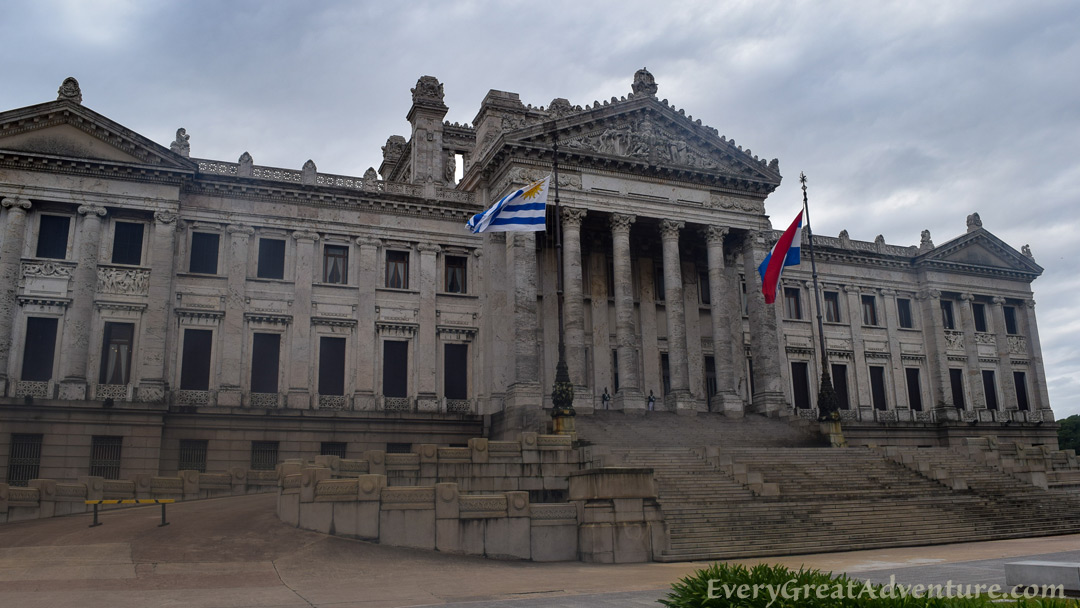
One thing that we noted on the tour was that many of the churches we saw, which were Catholic, were locked up and appeared unused. Our guide explained to us that although Catholicism is this their primary religion, most don’t practice the faith. As a result many of the churches have closed. The main cathedral downtown, which we explored on our first visit, is still open.
Back into Town
After the tour, we went back to the ship for lunch and then returned to the downtown area. The pedestrian walk was very quiet. There were a few shops open, but mostly it was families out taking walks on a beautiful Sunday afternoon. This time we headed straight to Independence Square and the Tango Museum.
To our surprise, we found the Tango Museum to be operated by the same group that runs the Salvo Palace tours and we were able to purchase one ticket that included both tours for 350 pesos per person.
Comprised of just two rooms, the Tango Museum tour was rather short. However, our guide was very good. She explained the history of the dance and the significance of the location we were in, as well as the creation of la Cumparsita and its author.
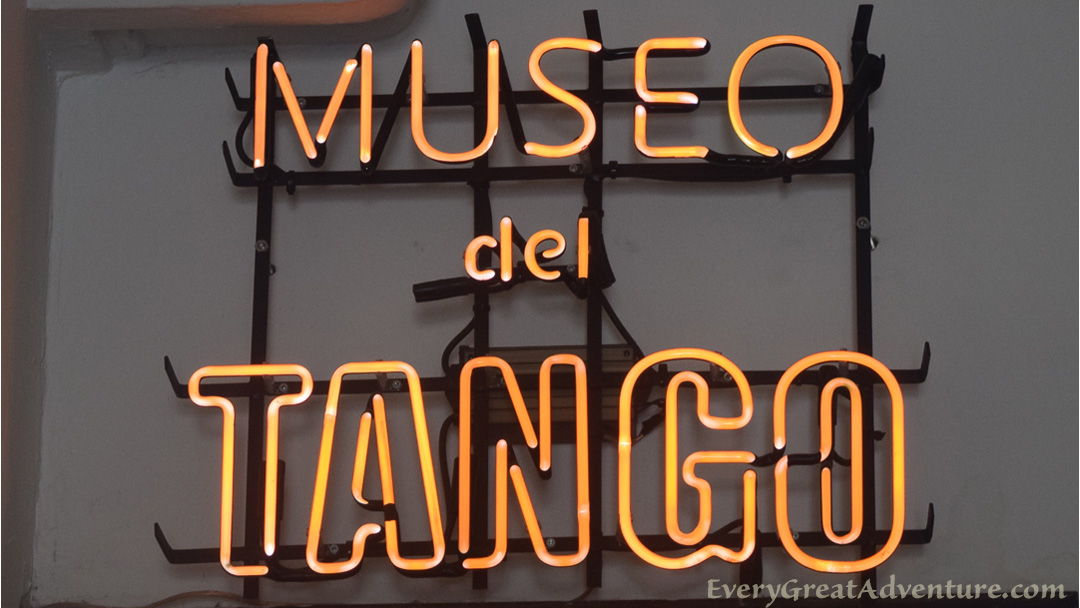
Palacio Salvo
Then we were off to the Palacio Salvo tour. The Salvo Palace is a mere shadow of what it was in it’s glory days; when it opened it was the tallest building in South America. We were provided with a lot of information about the history of the Salvo brothers and the construction of the hotel. From here we went up to the 23rd floor for a panoramic view of the city. Although the view was not 360°, it was very beautiful and allowed us to see most of where we had been on our earlier city tour.
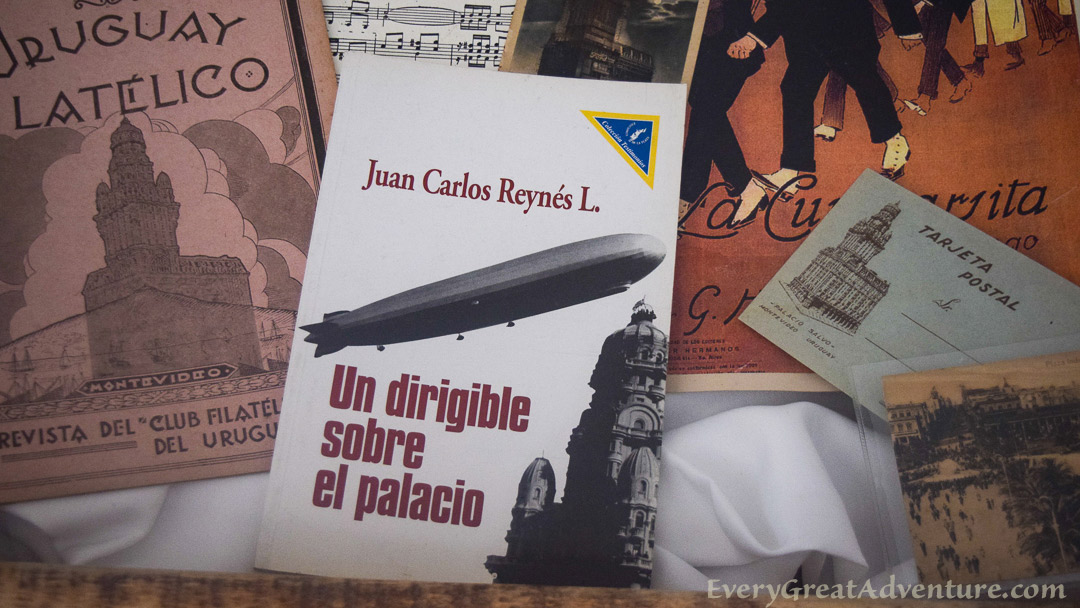
The Zeplin and Palacio Salvo
We then went down to the 10th floor, which had been the operations center of the hotel. Our guide took us into the office of her boss, which also had a small gift shop. Earlier on our tour, we had expressed interest in a picture of the building that showed a Zeppelin near the tower. Our guide’s boss showed us videos of the Zeppelin flyover which occurred in 1934. The video made it apparent just how large the Zeppelin was. We could also see that, although smaller than it currently is, the city of Montevideo appeared to be much more densely populated. It was amazing footage, and we appreciated that they took the time to share the video with us.
Both of our tours were bilingual. There was a Spanish speaking couple with us on the tours. Our guide would do the description in one language, then the other, which worked fine. Although heavily accented, both guides spoke English very well. It wasn’t a problem, it just meant we had to listen closely; if we didn’t understand a word or phrase we would ask them to repeat it. Both young ladies were very pleasant and even apologized for their English, which was totally unnecessary; their English was way better than my Spanish will ever be.
Punte del Este
This time, due to the high winds, our ship was anchored deeper in the harbor. Unfortunately, that meant we were farther away from the pier, and had to take a fairly rough tender ride. We elected to just walk through the town. On our walk we came across these interesting bells outside of a church.
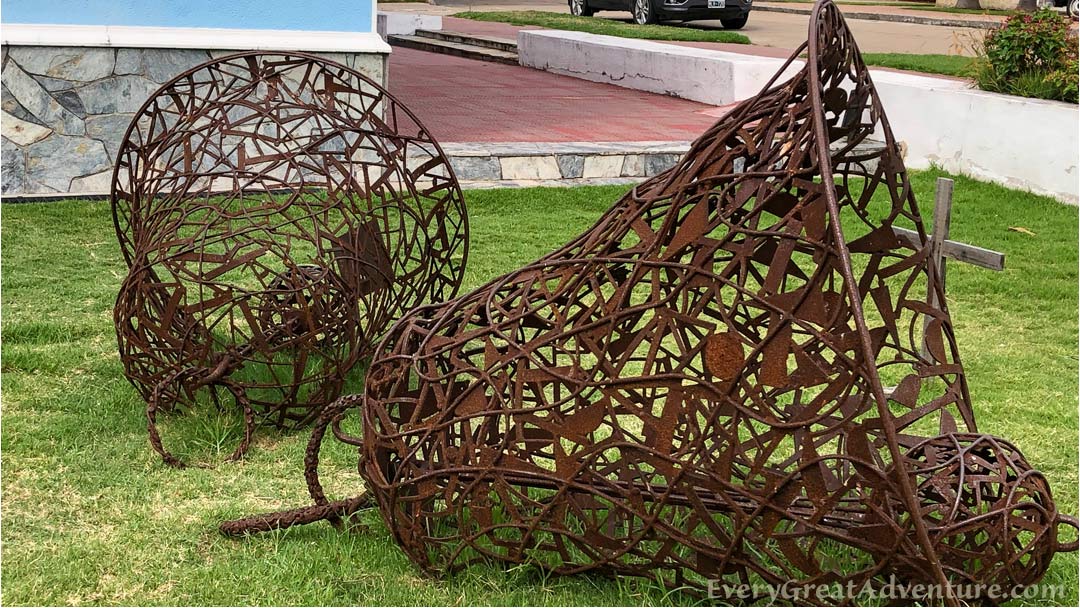
This stop in Punta del Este was the last duplicate port. The previous segment of our South American cruise had stops in both Punta del Este and Montevideo before ending in Bueos Aires. From here on out, the ports were new to us.
The Falkland Islands
The ship simply buzzed with excitement; finally the penguin tours! Of course there was also a lot of excitement over the fact that after two days of heavy seas, the ship was actually still!
Even for me, it was a long two days of relentless pitching as we made our way south to the Falkland Islands. Thank goodness the ship’s stabilizers were fully functioning or we could have also added heavy rolls to the pitching. We were sailing through a storm of heavy winds – heading almost directly into the wind. There were some people who huddled up in their cabins, but as most of the travelers on this trip were seasoned cruisers, they handled the heavy seas well. I suspect more than a few were taking mezcaline (Bonine) to help them through, and I noticed quite a few were using the patches behind their ear.
We Were Fortunate
I can say that everyone was pleased that we had made it to the islands. Often, on South American cruises, the weather is too rough and this port of call is cancelled, as a long tender ride is required to get from where the ship anchors to Port Stanley’s dock. But we made it and the tender ride was one of the smoothest of the entire trip.
I think people were so happy to be able to stand upright without being jostled around that they ignored the fact that the temperature was in the low 40’s with overcast skies, and there was even a bit of sleet. It was hard to believe that just a week prior we were in 98°F weather with our skin sizzling in the sun! So although the weather wasn’t perfect, we had made it to the Falkland Islands and were happy to be there!

Port Stanley
Our day began with a two and a half hour walking tour of Port Stanley. Our tour guide, although not a native, was very knowIedgeable. He first explained that the local currency is indeed pounds, but Falkland pounds, not British Pounds. Although the islanders will happily accept British pounds, change is given in Falkland pounds. Unfortunately, Falkland pounds are absolutely worthless anywhere else in the world. So – note to self – use credit cards for purchases made on the islands.
The tour was very interesting, and I’ll have to use another post to give you more detail about it. For this post, I’ll just give you the highlights. We stopped at the cathedral built in 1892, which had some interesting stained glass windows. At the Ministry of Minerals we learned that tourism is the fourth largest source of income for the islands; third is agriculture, second is crude oil, and first is the sales of fishing licenses. Apparently squid is quite abundant in the area and is able to be fished in a sustainable manner. So that was a bit of a surprise!
Falkland Islands War
We walked around the city and learned more about the everyday lives of the people of these islands. Our tour ended with a stop at the Falkland Islands War Memorial. Amazingly only four locals were killed during the 74 day siege in 1982. The battle was brutal, mostly hand to hand combat. Sadly, between the two countries, over 900 soldiers lost their lives during this short conflict. To this day there is still a lot of animosity between the British and Argentinians over the sovereignty of the island.
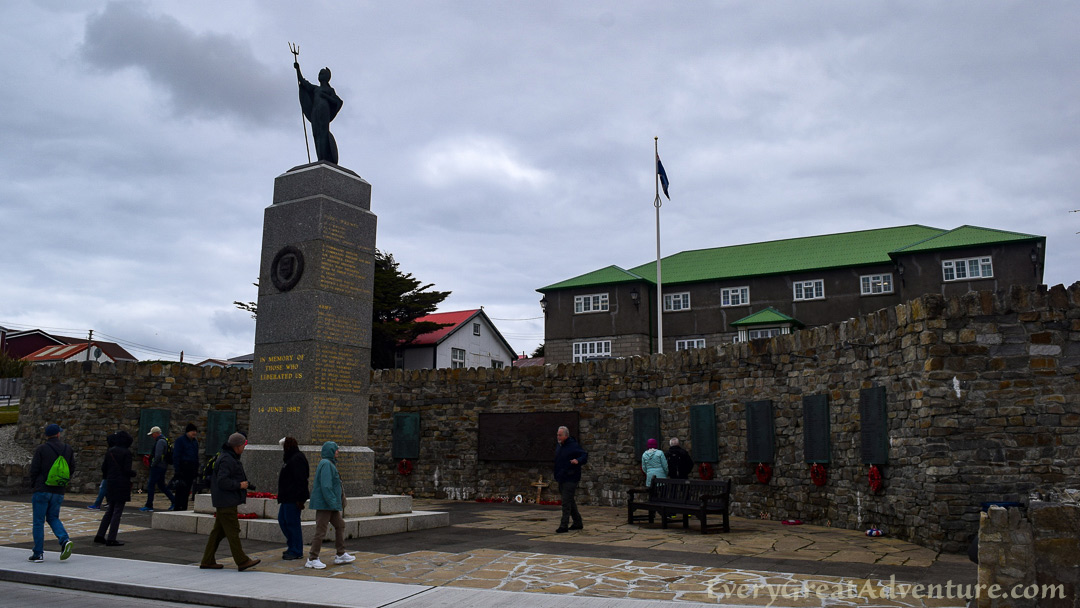
Ushuaia, Argentina
I was simply awestruck by the beauty of this town of about 70,000 residents. The town is surrounded by mountains and water. The sun made a brief appearance which made for an absolutely stunning arrival in port!
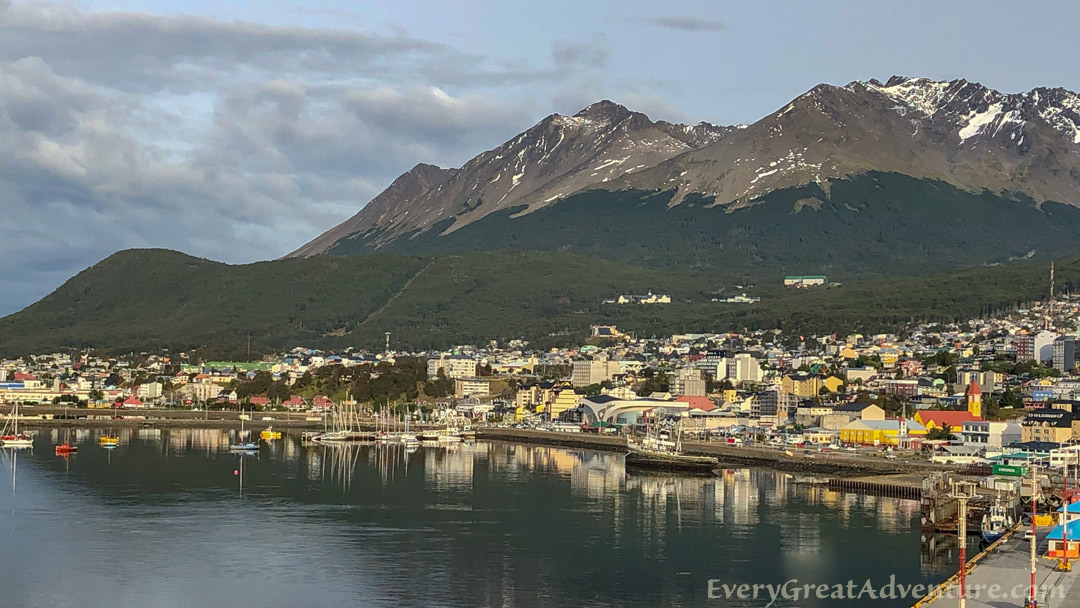
Even though it was the end of the summer season, there were three cruise ships in port, and there appeared to be quite a few tourists in town. I assumed they were tourists, many had huge backpacks and we saw many groups getting into the tour boats. There is a lot of wildlife nearby, but we elected to stay in town; many of our new friends from the ship were going on the penguin tours. It finally occurred to me that seeing penguins may be a factor in choosing to take a South American cruise!
The weather was cool, and we wore layers. As we were walking around Art got warm and had his jacket partially unzipped, revealing his US Naval Academy sweatshirt. A couple walking past saw the sweatshirt and stopped us to chat. It turned out that the man was a 1963 graduate of the Academy. He and his wife were getting ready to board a ship to take them to Antarctica. We chatted for a few minutes before continuing our walk through town.

During our walk we came upon the Malvinas War Memorial, a tribute to those who lost their lives in battle. Placards are posted around the park showing the human aspect of the war. Unfortunately, many were very faded and in need of replacement. The reason for the memorial was not lost on us; even a brief war is ugly, and lives are tragically lost. In the view of the Argentinians, Britain continues to unlawfully occupy their islands.
Punta Arenas, Chile
Cruising around Cape Horn, one of the reasons many people take a South American cruise, was rather uneventful. The weather did not lend itself to taking many photos as we rounded the most southern point of South America. Punta Arenas, the southern most city on earth, was our first stop after rounding Cape Horn, and a pleasant surprise. Home to over 124,000 people, the city was larger than we expected. Since the weather was good, although a bit chilly, we decided to spend the morning walking around the town.
We felt very safe as we walked through the town on our own. As it was Monday, most people were going about their daily business. There was a large square in town with a statue of Magellan and there was a street musician playing his pan flutes. Although it’s setting was not as striking as Ushuaia, the town had a charm of it’s own. The architecture was beautiful, reminiscent of Europe.
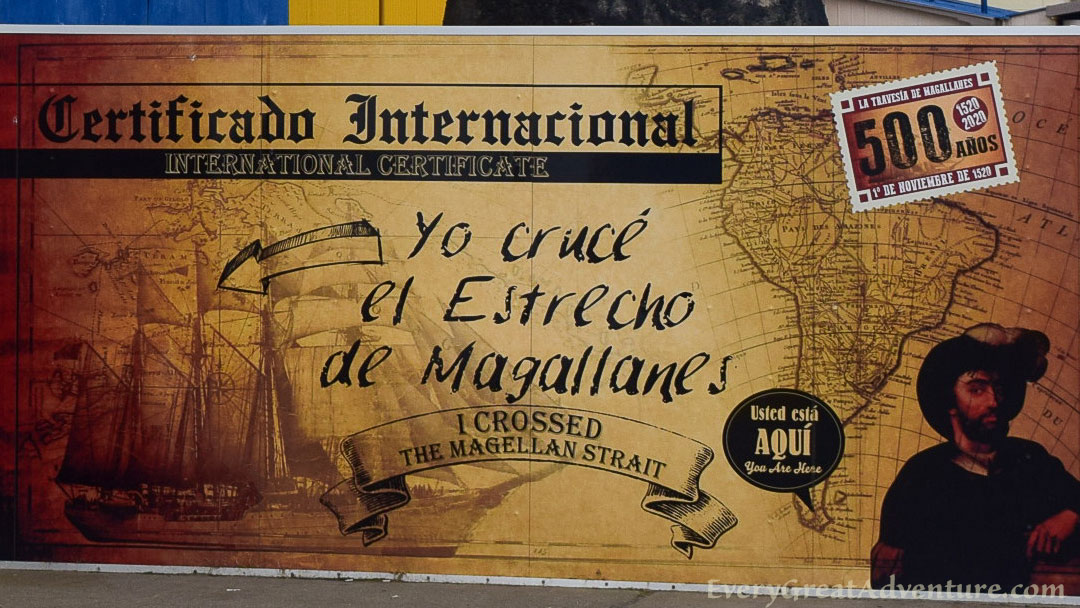
We walked about two miles to the huge cemetery and then walked back to the ship. The cemetery was amazing. It was similar to the cemetery we went to in Buenos Aires; many of the crypts were elaborately decorated. The grounds were very inviting. It was a great place to walk around and enjoy the day.

Although we had been told that Ushuaia was the launching point for Antacrtic expeditions we saw a lot more of that type of activity in Punta Areneas. In fact, we watched as a Brazilian ice breaker and research ship that was docked near ms Sirena loaded supplies. I am not sure if she was heading to Antarctica or back to Brazil, but they were loading a lot of supplies.
South America’s Fjords
We spent two days cruising the Chilean Fjords. The highlight of which was to be our visit to the Amalia Glacier. Although we saw a few rays of sunshine, Mother Nature was not terribly cooperative on this portion of our South American cruise. For the most part it was too cold and rainy to properly admire the scenery. We barely saw the glacier due to the rain and low clouds. We did manage to get a glimpse of the two plus miles of the glacier where it met the water. The captain sent out a rescue boat to snare a chuck of glacial ice from among the bergy bits floating near the ship. So, based on this experience, I would say the glacier viewing on a South American cruise is not as good as on an Alaskan cruise, but impressive non-the-less.
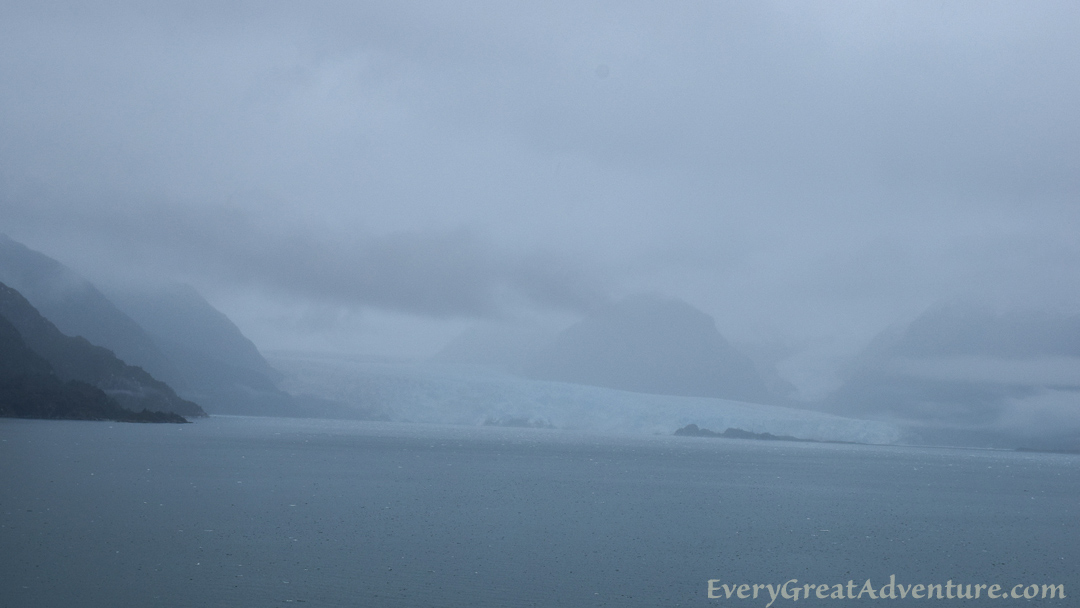
Puerto Chacabuco
This little Chilean town had to be one of the most beautiful sights we have ever seen. Of course it was the first time we had a sunny day since we were in Punta del Este, so that really added to the beauty. The setting was amazing. We tendered into the pier, and then took the shuttle into the town. We were warned that the town didn’t have much to see. Located in northern Patagonia, most of the ship’s tours were wildlife or outdoor oriented. We walked around the town and visited the rustic Hotel Loberias del Sur at the top of the hill. On our way back to the ship we visited the handicraft stalls located in two geodesic tents. There were some very nice handicrafts there, but unfortunately, I didn’t bring enough cash to make any purchases.
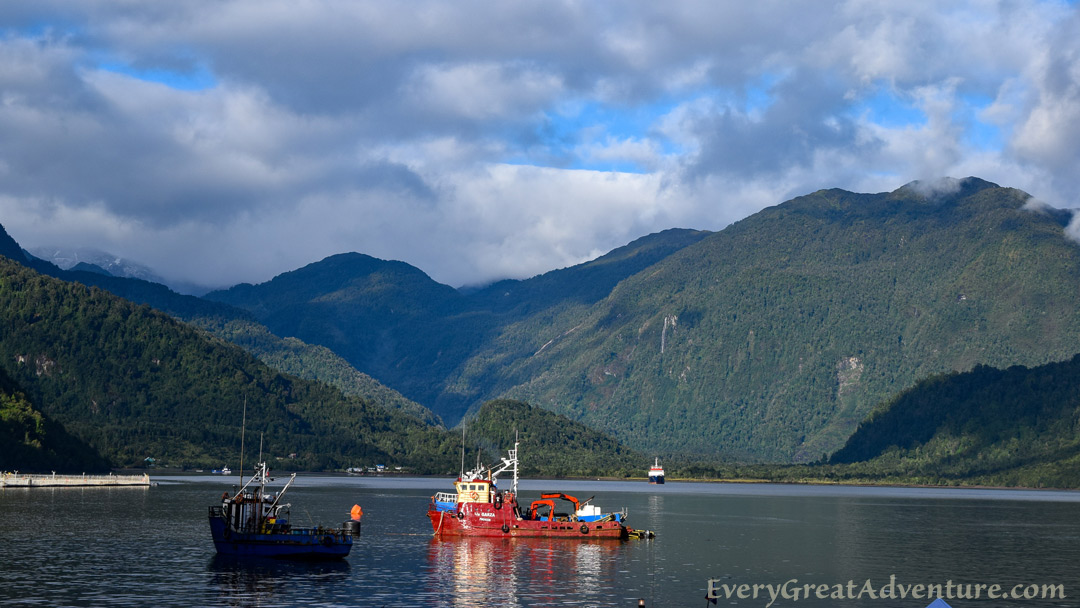
Puerto Montt
Another stop for the nature lovers; featuring tours to an extinct volcano, the scenic Petrohue Falls, and an ancient forest. Art and I once again elected to walk into the town, which was less than a mile from the port.
It was Friday and the locals were taking care of business. It seemed like every other street corner had a fruit stand set up on it. Every time we walked by one of the these stands, I would enjoy a heavy whiff of strawberry. I don’t know if they were grown locally or not, but they sure smelled wonderful.
We did go into the Cathedral of Puerto Montt; unusual in that it is made of wood. We also stopped at a peculiar statue, Sentados Frente al Mar which translates to sitting looking at the sea. It’s a large, rather crude, statue (possibly made of concrete) of a man and a woman looking out to the sea. All in all, it was another pleasant day.

San Antonio
With a lot of empty buildings standing in disrepair, San Antonio did not appear very inviting. Apparently the town has been damaged by numerous earthquakes and tsunamis over the years and, according to our guide, many people had left the town. All of the ship’s tours were going to either Valparaiso or Santiago. We elected to visit Santiago, the capital of Chile.
Santiago
With over seven million inhabitants, Santiago is a very cosmopolitan city. We were fortunate to arrive on a Sunday, so traffic was light. At seven hours, this tour was a long one. After about an hour’s ride we arrived in downtown Santiago at the Presidential Palace where the Chilean president and cabinet members run the country. From here we went to the main square where we saw several municipal buildings and the Metropolitan Cathedral.
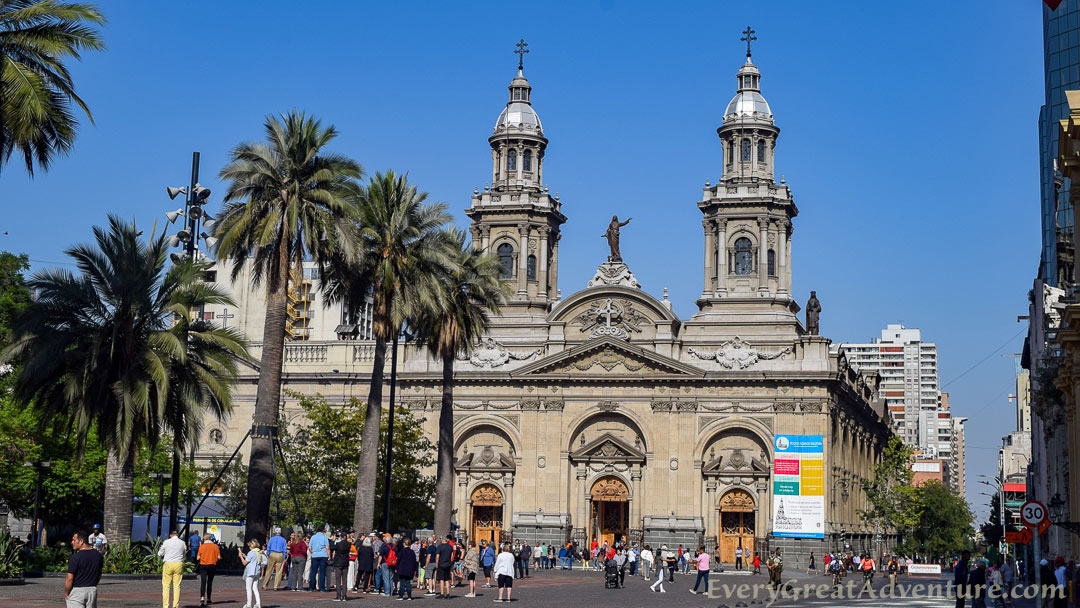
We left the central portion of town and went out to the artisanal market of los Dominicos. If you’re looking for souvenirs, this is the spot. Everything from woolen products to wood carvings to jewelry to paintings; all made by local artisans. It’s all presented in a lovely setting. I did purchase a beautiful wool poncho as a memento of this South American cruise. Absolutely worth a stop, even if just to browse.
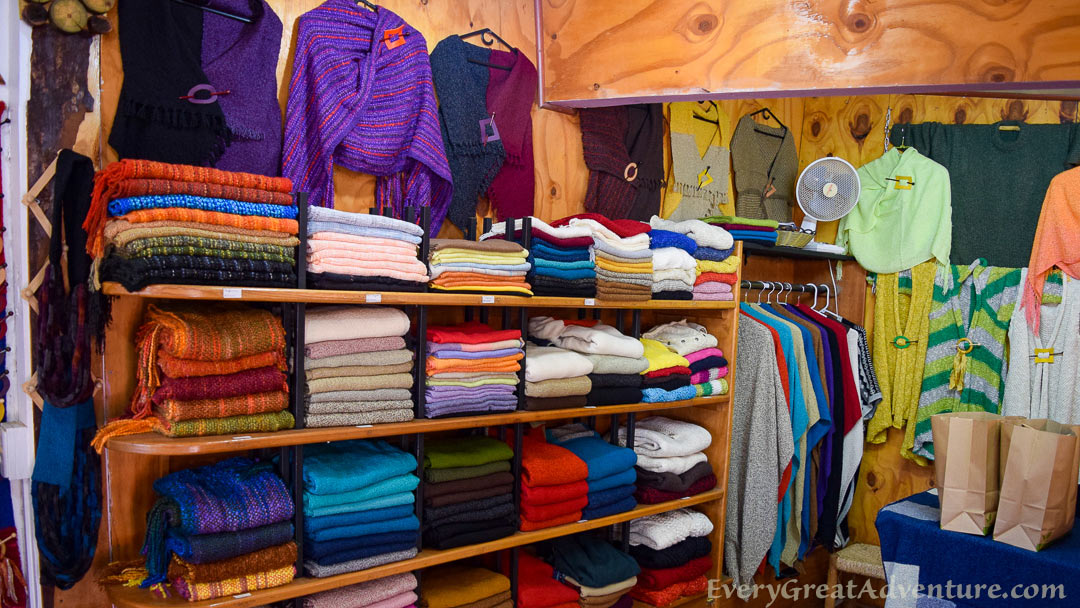
After leaving the market, we headed back towards town where we stopped at the area known as Bellevista. Although there were numerous restaurants to choose from, we only had about 45 minutes and were not sure if we could be served quickly enough at one of the sit-down restaurants, so we went to McDonald’s. (It was actually our first fast food in seven weeks!) There were more shops in this market, and we even found a Starbucks! This was the first Starbucks we had seen on our trip; although we don’t care for their coffee, we do collect their souvenir mugs!
Our last stop was San Cristobal Hill. From here we were able to get a nice view of Santiago before heading back to the ship in San Antonio.
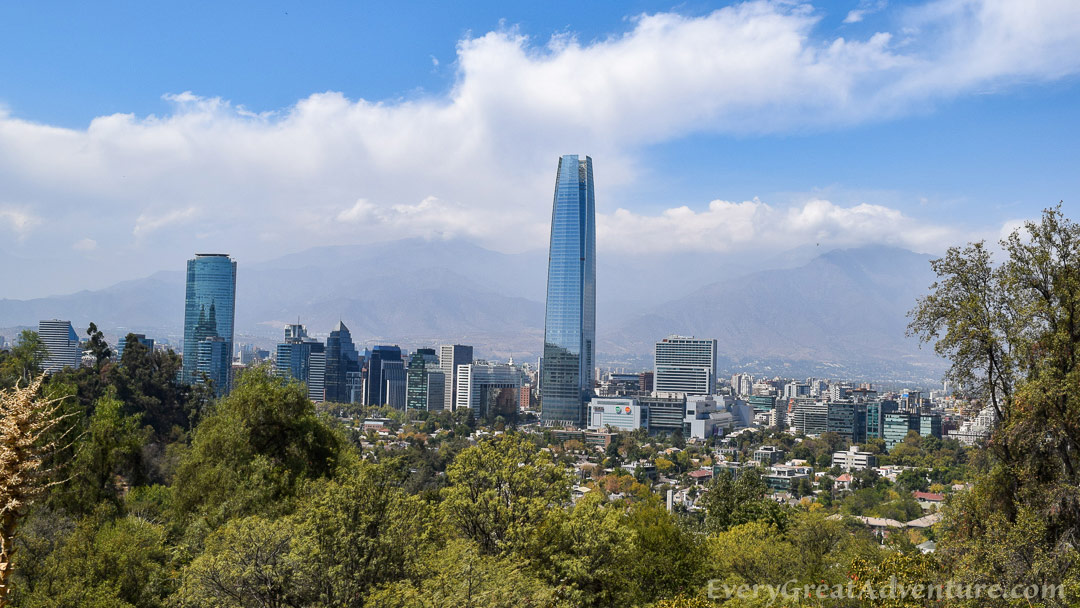
Coquimbo
Another smaller port town, Coquimbo had a charm all its own. The towns of Coquimbo and La Serena are joined together by a long beautiful beach.
Apparently, pirate ship cruises are the thing to do, as there were numerous pirate ships in the harbor. The town built its importance on gold and copper mining. Since there is a pirate ship on the city’s crest, I am guessing pirates played a role in the development of the city.

And pelicans; I have never seen so many pelicans at one time! From the information that I found, these are Peruvian pelicans, and are apparently a threatened species. For whatever reason, climate, availability of food; they like Coquimbo.
Up on top of a very steep hill sits the largest landmark of the city, the Cross of the Third Millennium, which was opened in May of 2000. At 83 meters (272 feet) tall, and 40 meters (131 feet) wide it dominates the city. The cost of entry is 2000 Chilean pesos, which at the time I write this is less than three US dollars.
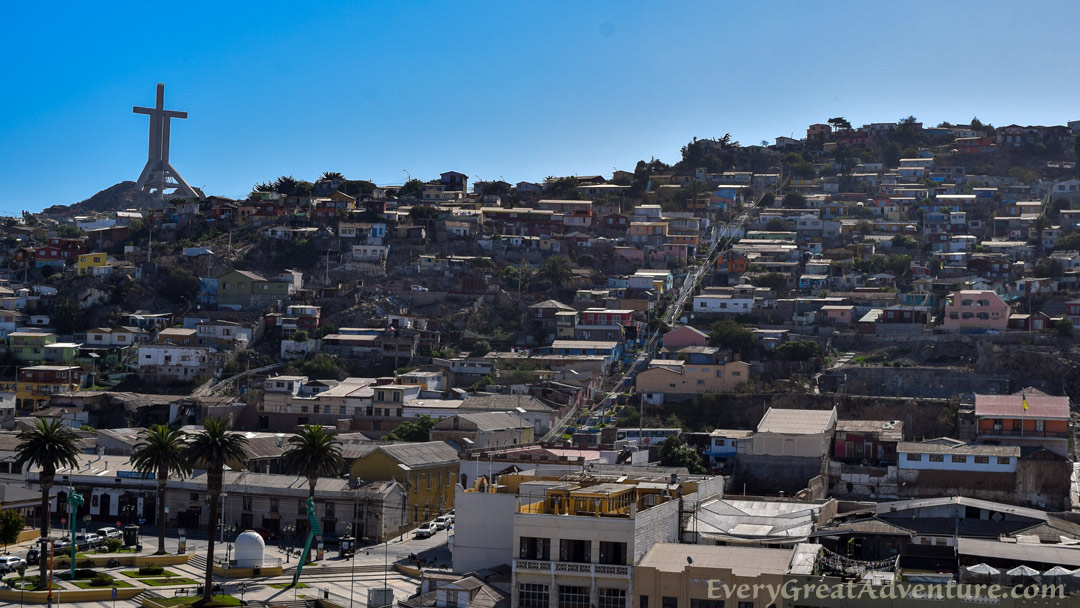
We spent the better part of the morning walking around town and wandered into a very nice mall. There is also a large casino in town. Near the pier there were numerous stalls for shopping, along with a very large fish market.
Iquique
This was an interesting stop. Our tour book of South America listed Iquique as being in Peru, but as of 1873 it has been a part of Chile. The town was built on the mining of Chilean saltpeter (sodium nitrate).
The shuttle dropped us off in the center of the old town at the main square. This was another town that must have been absolutely stunning in its heyday. Some on the buildings had been very well preserved, and others stood in decay, a sad reminder of a more prosperous time.
There was a long pedestrian street which used to accommodate the trolley. On either side of the road was a wide wooden sidewalk. We noticed many of the old buildings were also made of wood. After doing a bit of research, I found that Iquique is one of the driest cities in the world, which makes sense that wood was commonly used in construction.
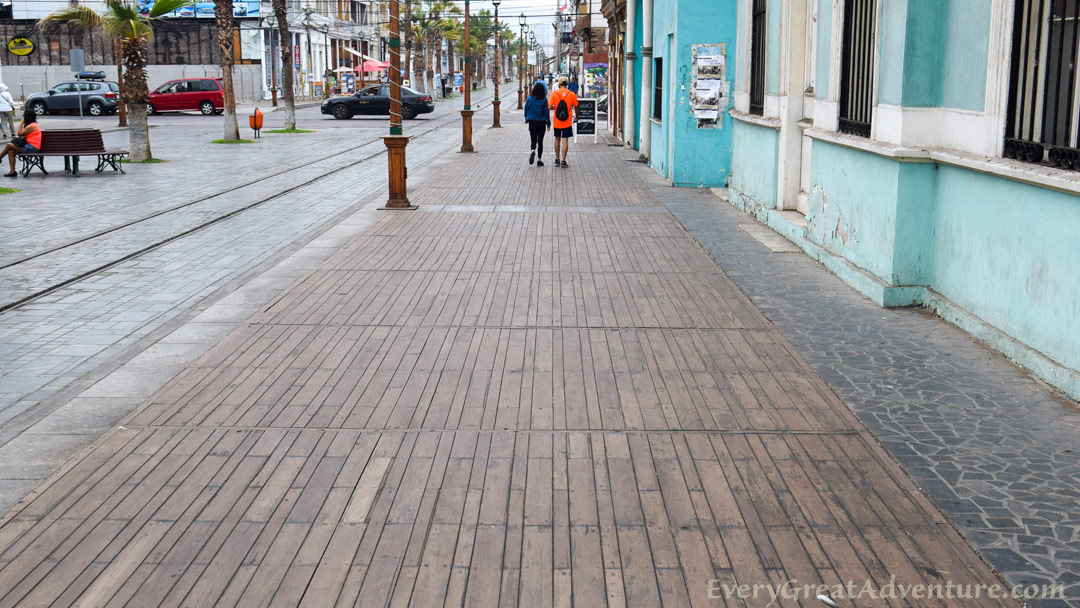
There were several museums along the pedestrian walkway. We went into the Regional Museum, which was free. It was an interesting museum showing the history of the area. We walked though a lot of the old town before heading toward the harbor.
Exploring Toward the Harbor
On our walk we went through the fish market and then to a beautiful replica of the three masted corvette, Esmeralda. The original ship was lost in the Battle of Iquique during the Pacific War and is significant in the history of the region. Unfortunately, they only accepted cash in pesos, and since this was our last stop in Chile, we didn’t want to change any money, so we didn’t go into the museum.
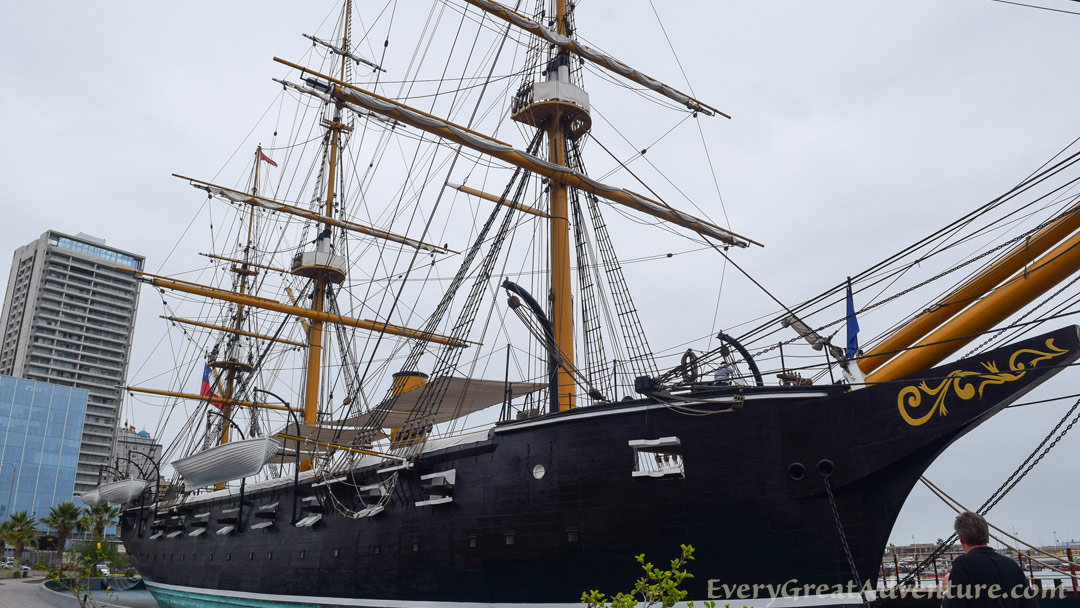
On our way back to the shuttle stop in the main square, we came upon the Iquique Cathedral, built in 1882. It was not as elaborate as I expected, but it was beautiful.
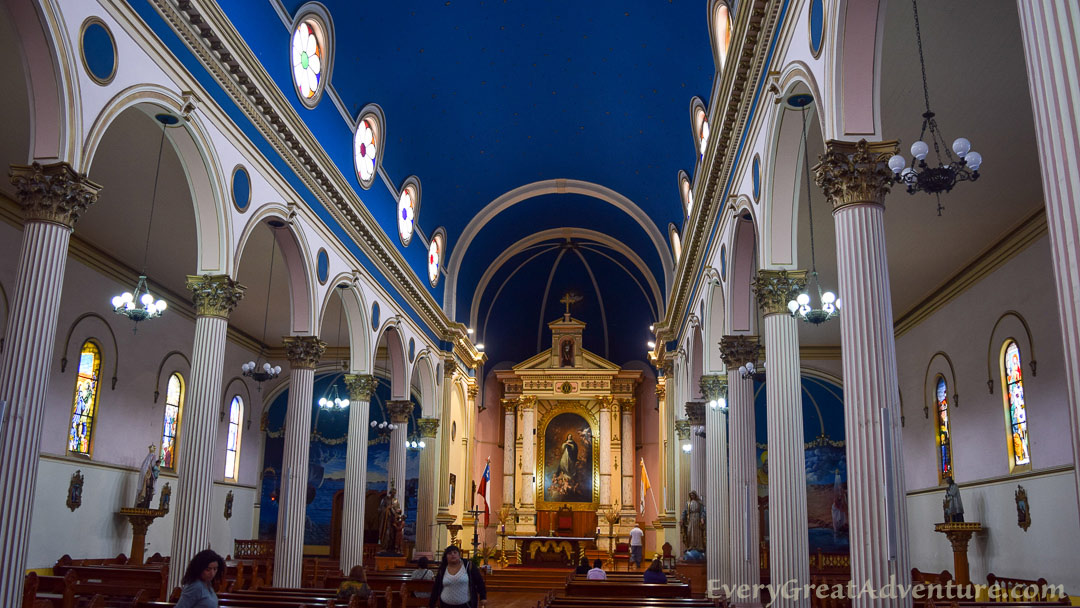
Pisco, Peru
The port is about 23 miles from the city of Pisco; if you weren’t taking a tour, there wasn’t much to see or do at this stop. We had flown over the Nasca Lines on an earlier trip to Peru, so we stayed on board the ship and began our packing. It was hard to believe our South American cruise was coming to an end.
If you have the opportunity, I do recommend taking the flight seeing over the Nazca Lines, a UNESCO World Heritage site. The way they fly the planes allows for everyone to see the geoglyphs. It involves sharp banking in each direction; even if the weather is good, you may still get a little queasy. It was definitely worth doing; but unless I was flying in the co-pilot seat, I don’t think I would do it a second time. Here’s a photo of the hummingbird from our flight over the Nazca Lines. (Look carefully and you’ll see it.)
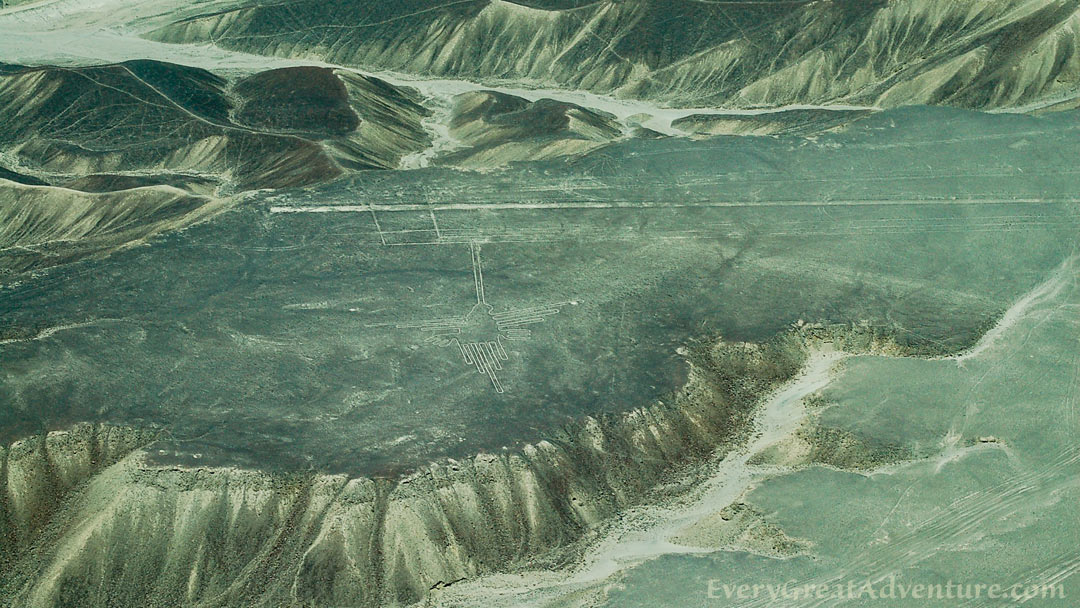
Lima
We somehow managed to fit everything in the suitcases. We didn’t purchase a lot of souvenirs, so we didn’t have too much additional weight in our bags. I did have to do a bit of rearranging to make sure none of the bags were overweight.
Our flight was not scheduled to leave until 10 pm, so we were able to go to the hospitality suite at the JW Marriott Lima that Oceania Cruises provided for those of us on late flights. It’s a beautiful hotel in a lovely area of Lima, called Miraflores. We stayed at the hotel for a while then walked around the park across the street and then the nearby Larcomar Mall. We did a lot of window shopping, followed by a nice leisurely lunch. You can also spend time watching the surfers and, if the winds are right, the paragliders.
Flight Delayed
Our flight was scheduled to leave a little after 10 pm. The cruise line had a shuttle arranged to take us to the airport; we were supposed to leave at 4:30 pm. We were notified that our flight would be delayed, and they delayed our departure from the hotel until 6pm. So, although we had a long day, at least we were comfortable and had food and beverages available for us the entire day.
Our flights home turned out to be less than desirable. Our 10:15 pm flight did not depart Lima until nearly 3 am. Since they knew we would not make our scheduled connection, the airline ended up putting us in a hotel in Miami for the night. We were rescheduled to go to Columbus, via New York the next morning. As a result, we had a break in our trip home and stayed at the beautiful EB Hotel near the Miami airport. I was glad I had done another load of laundry while we were in Pisco, that gave us enough clean clothes to wear on the way home! So yes, we were inconvenienced, but we did make it home safely, just a day later than we planned.
Home at Last
After being gone a total of 60 days, our South American Cruise adventure ended. We arrived home to find the house still standing, and remarkably, no snow on the ground! It was cold, but not unbearable. Going through all the mail was interesting. There were only a couple of bills in the mail that came while we were away.
It was difficult after sixty days of traveling to get back into the swing of things. Things like making the bed, cooking, cleaning up the kitchen, cleaning the house… you know, all those things that make taking a vacation so nice!
However, it was good to get back in our own bed with our own pillows. It was also nice to have all our own stuff again, in familiar surroundings. It felt so luxurious to be able to spread out! There is nothing better than traveling the world to remind you of that simple truth, that no matter how interesting, or beautiful, there’s no place like home!
Our South American Cruise
I hope you enjoyed reading about our adventures. Did you read about the first two segments of our South American Cruise; Miami to Rio and Rio to Buenos Aires? I hope you didn’t miss the story about our side trip to Iguazu Falls! If you’d like, you can just take the visual tour in our photo journeys!
How about you? Have you visited South America? Traveled for an extended period of time? Any tips you’d like to add? I’d love to hear about your experiences!
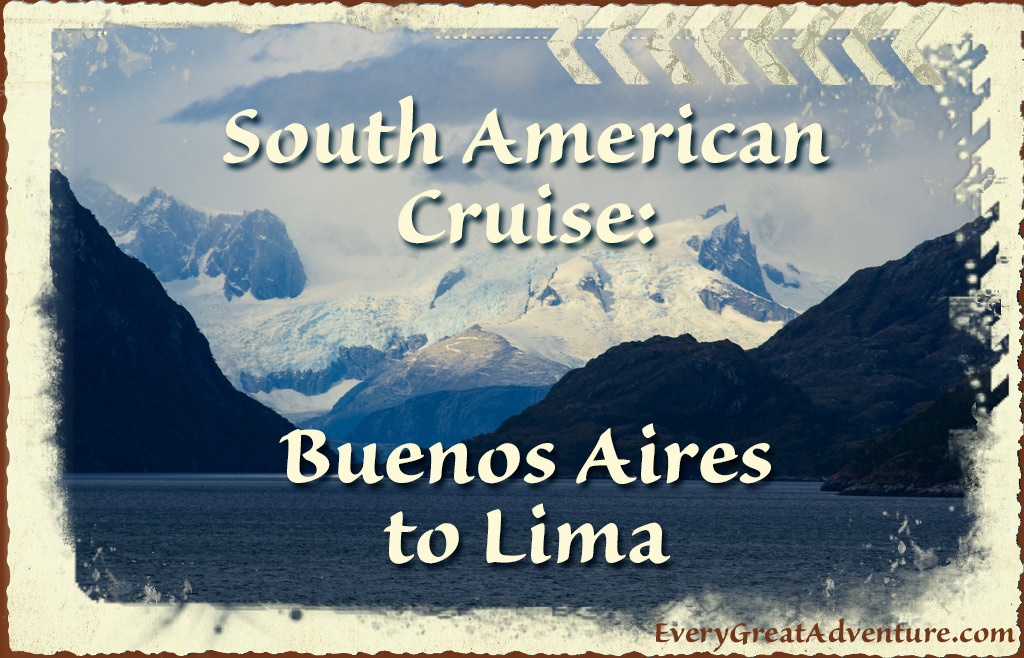
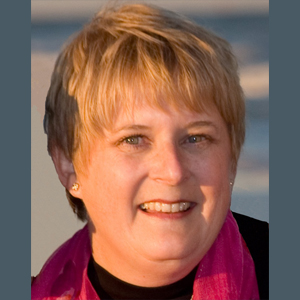
0 Comments